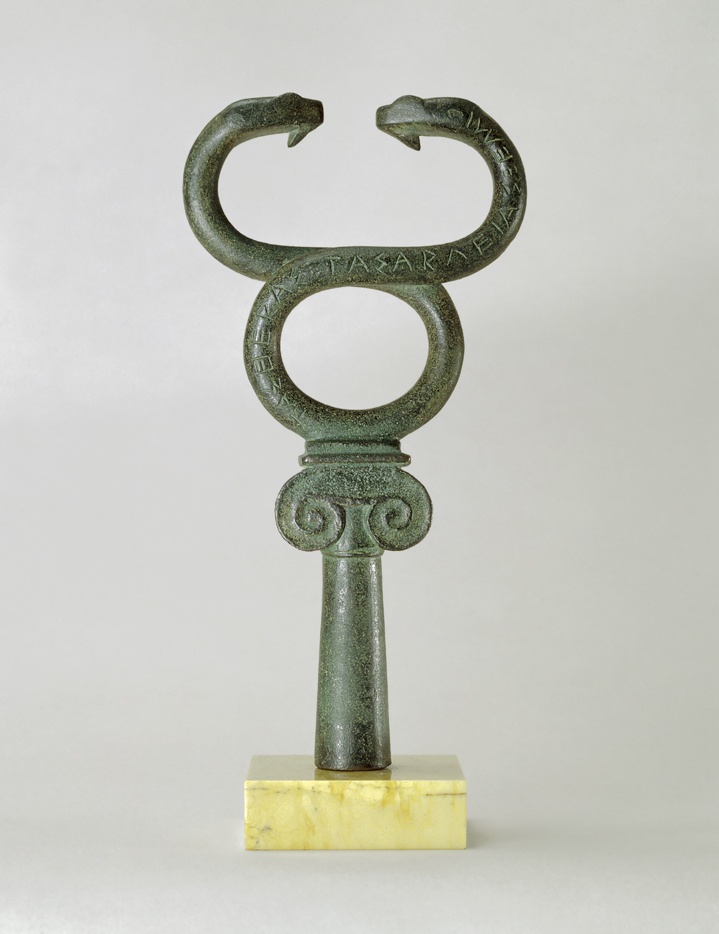
Bronze
H: 17.2 cm
From Polyrrhenia (Crete)
Cretan?
First half of the 5th century B.C.?
Solid-cast by the lost wax process with hollow column shaft below capital for affixing on top of a wooden pole [1]. Dedication inscribed in the cold.
Condition: green patina with medal-colour bronze appearing in places and traces of earth.
The origin of the kerykeion is not known; but already in Homer's time it is associated with Hermes appearing as a golden forked twig, his attribute as the "bringer of blessings" [2]. It was a herald's staff. Heralds were messengers, ambassadors who fulfilled important political, military and religious functions, beyond compromise and held in high esteem in Homeric society. Their office carried a mystical significance. They were the divine successors of Hermes.
Kerykeia were used as cult objects in sanctuaries and dedicated as votive offerings either new or after having served. It is only from the 5th century onwards that kerykeia end in animal heads and the first example with snakes is on a cup by Macron [3], c. 480/70 B.C., found on the Acropolis.
Notwithstanding the Archaic form of the Ionic capital [4] and the relative simplicity of the snakes' heads, we feel that the present example, though it may be the earliest we know, is of Cretan manufacture [5] and possibly to be dated in relation to its inscription6 in the first half of the 5th century B.C.
Any difference in time between the manufacture and
the inscription is not likely to exceed more than two or three decades.
However, if the function of herald was hereditary, the kerykeion could have passed on from one generation to another and have been dedicated a considerable time after manufacture.
On view: Antikenmuseum, Basel: 1967-1968
Exhibited and Published:
Meisterwerke griechischer Kunst, cat. no. V 184,
pp. 180, 225 ill.
Published:
Vlasova, E.: Bronze Kerykeion, in:"Hermitage Readings". The George Ortiz Collection, St. Petersburg (12 April 1993), pp. 12-13, 25.
Mentioned:
Hornbostel, W.: Syrakosion Damosion, JbHamKuSamml 24, 1979, pp. 33-62, part. 51, 54. - Antiquities from the Christos G. Bastis Collection (Mainz, 1987), no. 96, p. 188. - Kirchhoff, W.: Die Entwicklung des ionischen Volutenkapitells im 6. und 5. Jhd. und seine Entstehung (Bonn, 1988), p. 321 n. 663.
1 Akin to a bishop's crosier.
2 Crome, J.F.: Kerykeia, AM 63/64, 1938/39, p. 125.
3 Crome, J.F.: loc. cit., p. 124.
4 Which led Karl Schefold (Meisterwerke, p. 40) to date the kerykeion in the 6th century B.C., though he placed the inscription towards the middle of the 5th century.
5 Regarding Hera and Crete, Prof. Philippe Borgeaud wrote us as follows in a letter dated 30.7.90: "L'absence d'une Héra explicitement argeia ne doit toutefois pas nous interdire de penser que son importance comme argienne était inconnue en Crète, loin de là: en plein milieu du 5ème s., les cités de Cnossos et Tylisos font appel à la médiation d'Argos, et le traité qu'elles concluent, dont l'exemplaire argien a été retrouvé, fait état d'un sanctuaire d'Héra localisé en Crète".
6 We are indebted for this information to Th. Selov-Kovedjajev who studied the inscription at length and dates it in the second quarter of the 5th century B.C. and at the very latest in the middle of the century.